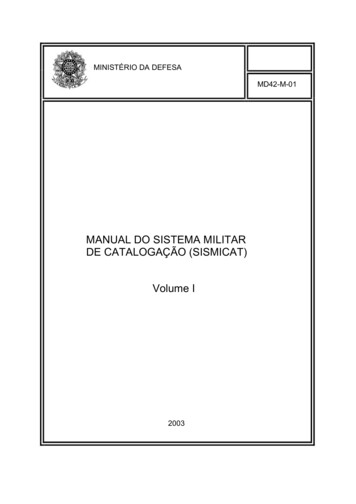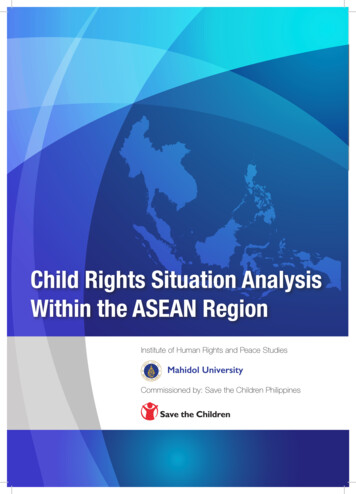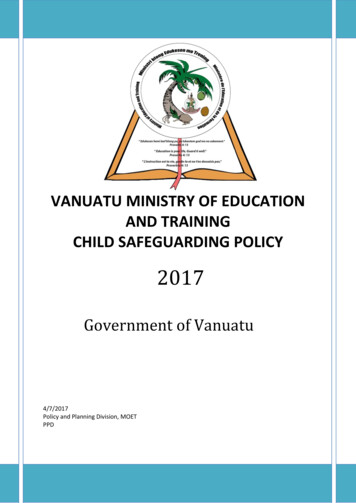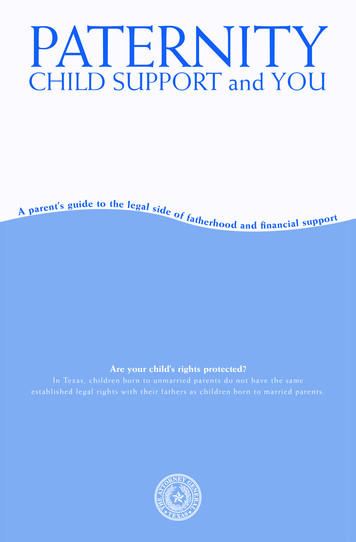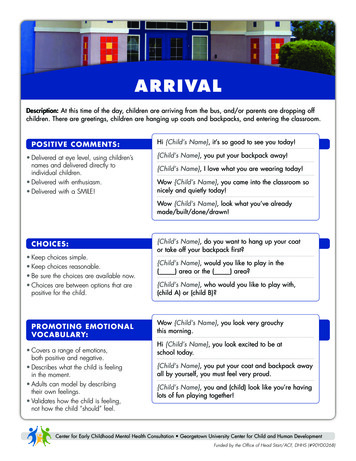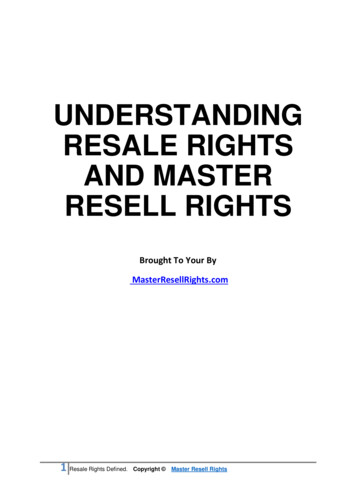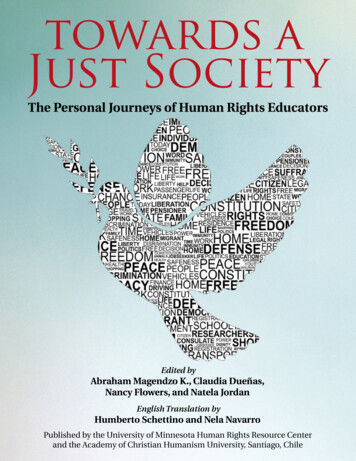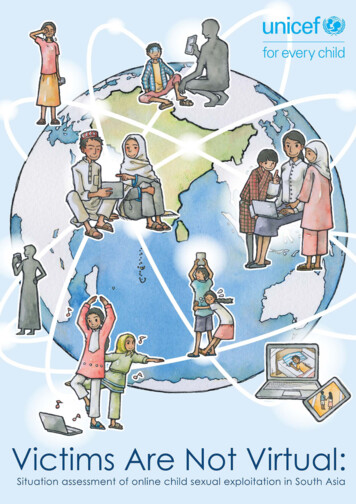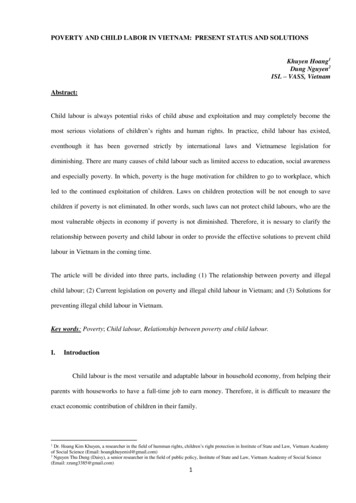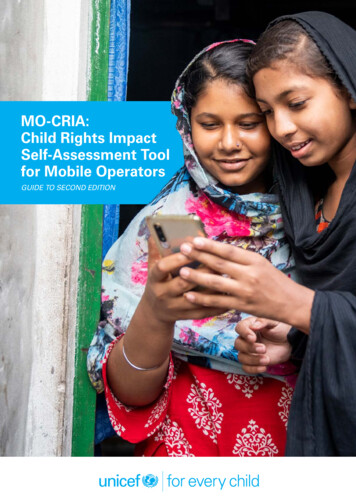
Transcription
MO-CRIA:Child Rights ImpactSelf-Assessment Toolfor Mobile OperatorsGUIDE TO SECOND EDITION
ACKNOWLEDGEMENTSThe MO-CRIA Self-Assessment Tool was updated by UNICEF’s Children’s Rights andBusiness team, led by Josianne Galea Baron in collaboration with Milka Pietikäinen.The tool has benefited from the invaluable contributions of several UNICEF colleagues,including: Afrooz Kaviani Johnson, Andrew Mawson, Caleb Segun Lean, Christopher Kip,Elisabeth Andvig, Emer O’Doherty, Erik Nyman, Hanna Cody, Jo Jewell, Katherine Ortiz,Marina Komarecki, Sarah Jacobstein, Sean Blaschke, Sigrun Kaland, and Steven Sadi.Many additional stakeholders contributed to updating the tool. A special thank-youto Emil Lindbald Kernell and Tulika Bansal (Danish Institute for Human Rights); PhilipLing Oon Hun (Digi); Anne Euler (GSMA); Fanny Rotino (ITU); Silvia M. Garrigo,Mauricio Arce León; Viviana Cano, Maria Paz Domínquez and Kathya Jara (MillicomTigo); Catherine Yap-Yang, Jose Felicisimo Rosete, April May Kagaoan, CharmineDimaculangan, Novaleeh Concepcion, Joyce Anne Quinan, Edmar Pasilaban (PLDT Inc.and Smart Communications, Inc.); Marijana Grubesic (Telemach Croatia); Heddy Ringand Patrik A. Hiselius (Telia Company), Annette Fergusson (Threefold Sustainability);Moira Thompson Oliver and Daisy Johnson (Vodafone); and Jennifer Suleiman, FatimaBehbehani, and Jasem Al Nafisi (Zain Group).Cover Photo Credits: UNICEF/UN0400930/HaqueCOPYRIGHT AND DISCLAIMERPlease send any comments and queries to CSR@unicef.org .All rights to this guide remain with the United Nations Children’s Fund (UNICEF).No part of this document may be replicated or redistributed without the prior writtenpermission of UNICEF.A reference to a non-UNICEF website does not imply endorsement by UNICEF of theaccuracy of the information contained therein or of the views expressed. United Nations Children’s Fund (UNICEF) 2021
MO-CRIA:Child Rights Impact Self-AssessmentTool for Mobile OperatorsGUIDE TO SECOND EDITION
ForewordMobile technology has become an integral part ofchildren’s daily realities all around the world – offeringaccess to a world of information and opportunitiesto connect, learn, play, and much more. With mobileaccounting for most broadband connections in low- andmiddle-income countries, the importance of the roleplayed by mobile operators in this increasingly digitalworld cannot be overstated.Indeed, the onset of the COVID-19 pandemic and theresulting surges in demand for mobile data around theworld have only served to further highlight the manyways in which meaningful access to mobile technologieshas become an indispensable lifeline for millions aroundthe world, including children. The contributions thatmobile technology can make to enhancing children’slives across different Sustainable Development Goalareas, from quality education to gender equality, havealso long been recognized.This second edition of the Child Rights Impact SelfAssessment Tool for Mobile Operators (MO-CRIA)offers a simple and yet comprehensive frameworkfor mobile operators seeking to build a deeperunderstanding of child rights challenges, opportunities,and impacts related to their business. The 2021edition builds on the experiences of companies whichimplemented the original tool.When considering the impact of mobile operators onchildren’s rights, it is a natural initial reaction to focusin on the digital environment itself. Of course, this is avital and necessary element of impact assessment—and this revised tool offers greater detail on this topic,reflecting the increased importance of consideringchildren’s rights online.But child rights impacts are also found in howcompanies manage facilities and assets, as wellas how they develop, produce, market, and deliverproducts and services – whether this is done directlyor through business partners and suppliers. Like allbusinesses, mobile operators have a responsibility torespect children’s rights throughout their operationsand through their relationships with employees,business partners, and other key stakeholders. Thisversion of the MO-CRIA self-assessment tool has beenupdated with guidance and considerations across thesedifferent arenas.Calls for companies to carry out human rights duediligence of their operations and wider value chain haveand will continue to intensify. In light of this, the MOCRIA self-assessment tool is a resource to support andfacilitate further action.Carla Haddad MardiniDirector, Private Fundraising and PartnershipsUNICEF2MO-CRIA: CHILD RIGHTS IMPACT SELF-ASSESSMENT TOOL FOR MOBILE OPERATORS
ContentsContents1. Introduction. 62. How To Use The MO-CRIA Self-Assessment Tool. 10Understanding MO-CRIA format and structure. 10Visual data outputs. 123. Carrying Out The Self-Assessment. 13Identifying the colleagues to involve in the assessment. 13Launching the MO-CRIA self-assessment process. 15Gathering input from colleagues. 15Additional inputs to the assessment. 16Acting on MO-CRIA findings. 184. MO-CRIA Guidance Tables. 191Corporate Responsibility/Sustainability and Compliance. 202Children and the Digital Environment. 273Human Resources. 324Products, Sales and Marketing. 385Procurement. 426Network Operations. 477Security. 495. Appendix. 51Frequently Asked Questions. 51Additional Tools for Companies. 51MO-CRIA: CHILD RIGHTS IMPACT SELF-ASSESSMENT TOOL FOR MOBILE OPERATORS3
AbbreviationsCRBPChildren’s Rights and Business PrinciplesCRCConvention on the Rights of the ChildCRIAchild rights impact assessmentCSAMchild sexual abuse materialDRCthe Democratic Republic of the CongoDRRdisaster risk reductioEMFelectromagnetic fieldGRIGlobal Reporting InitiativeGSMAGlobal System for Mobile Communications AssociationHRIAhuman rights impact assessmentsICMECInternational Centre for Missing & Exploited ChildrenICNIRPInternational Commission on Non-Ionizing Radiation ProtectionICTinformation and communication technologyGlossaryBestinterests ofthe childOne of the four core principles in the United Nations Convention on the Rights of the Child (CRC), this applies to all actionsand decisions concerning children. It calls for active measures to respect their rights and promote their survival, growth andwell-being as children, as well as measures to support and assist parents and others who have day-to-day responsibility forrealizing children’s rights.1ChildUnder CRC article 1, “a child means every human being below the age of 18 years unless, under the law applicable to thechild, majority is attained earlier.”Child labourAny work that deprives children of their childhood, their potential and dignity, and that is harmful to physical and mentaldevelopment. It is defined by the ILO Minimum Age Convention, 1973 (No. 138), and the Worst Forms of Child LabourConvention, 1999 (No. 182), and by the United Nations Convention on the Rights of the Child.2Child sexualexploitationand abuseDescribes all forms of sexual exploitation and sexual abuse, e.g. “(a) the inducement or coercion of a child to engage inany unlawful sexual activity; (b) the exploitative use of children in prostitution or other unlawful sexual practices; (c) theexploitative use of children in pornographic performances and materials”, as well as a “sexual contact that usually involvesforce upon a person without consent”. Child sexual exploitation and abuse increasingly takes place through the internet orwith some connection to the online environment.31 UNICEF, UNGC, Save the Children, ‘Children’s Rights and Business Principles’,: oduction/ 2 A more detailed definition can be found on the ILO website at ‘What is child labour’ https://www.ilo.org/ipec/facts/lang--en/index.htm 3 ITU, ‘Guidelines for Industry on Child Online Protection’, 2020, www.itu.int/en/ITU-D/Cybersecurity/Pages/COP.aspx 4MO-CRIA: CHILD RIGHTS IMPACT SELF-ASSESSMENT TOOL FOR MOBILE OPERATORS
Child sexualabusematerial(CSAM)Although many jurisdictions still label images and videos of child sexual abuse ‘child pornography’ or ‘indecent images ofchildren’, we refer to the issues collectively as ‘child sexual abuse material’ (CSAM).The term CSAM is used to refer to material that represents acts that are sexually abusive and/or exploitative to a child. Thisincludes, but is not limited to, material recording the sexual abuse of children by adults; images of children included in sexuallyexplicit conduct, and the sexual organs of children when the images are produced or used for primarily sexual purposes.This term more accurately describes the content. Pornography refers to a legitimate, commercialized industry and, as theLuxembourg Guidelines state, the use of the term: “may (inadvertently or not) contribute to diminishing the gravity of, trivializing,or even legitimizing what is actually sexual abuse and/or sexual exploitation of children. The term ‘child pornography’ risksinsinuating that the acts are carried out with the consent of the child and represent legitimate sexual material”.4ConflictmineralsMining of some metals and minerals used in mobile network equipment and devices has been linked to armed conflict in countries suchas the Democratic Republic of the Congo, by directly or indirectly benefiting armed groups. Mining in these conflict zones has also beenlinked to abuses such as child and forced labour and the use of children as soldiers. ‘Conflict minerals’, as defined by the US legislation,currently include the metals tantalum, tin, tungsten and gold (3TG), while the OECD ‘Due Diligence Guidance for Responsible SupplyChains of Minerals from Conflict-Affected and High-Risk Areas’ has a broader scope and covers all minerals, not only 3TG.5CyberbullyingCyberbullying describes an intentionally aggressive act carried out repeatedly by either a group or an individual using digitaltechnology and targeting a victim who cannot easily defend him or herself. It usually involves “using digital technology andthe internet to post hurtful information about someone, purposely sharing private information, photos or videos in a hurtfulway, sending threatening or insulting messages (via email, instant messaging, chat or texts), spreading rumours and falseinformation about the victim or purposely excluding them from online communications”.6GroomingGrooming/online grooming, as defined in the Luxembourg Guidelines, refers to, “the process of establishing/building arelationship with a child either in person or through the use of the Internet or other digital technologies to facilitate eitheronline or offline sexual contact with that person”. It is the criminal activity of becoming friends with a child in order to try topersuade the child to have a sexual relationship.7Notice andtakedownOperators and service providers are sometimes notified of suspect content online by customers, members of the public,law enforcement or hotline organizations. ‘Notice and takedown’ procedures refer to a company’s processes for the swiftremoval (‘takedown’) of illegal content, defined according to the jurisdiction, as soon as it has been made aware (‘notice’) ofthe presence of illegal content in its services.Parentalcontrol toolsSoftware that allows users, typically a parent, to control some or all functions of a computer or other device that can connect tothe internet. Typically, such programmes can limit access to particular types or classes of websites or online services. Some alsoprovide scope for time management, e.g. the device can be set to have access to the internet only between certain hours. Moreadvanced versions can record all texts sent or received from a device. The programmes normally will be password protected.8Control tools need to strike a balance between the right to protection from all forms of violence and exploitation, and auser’s rights to information, freedom of expression, privacy and non-discrimination, as defined in the CRC. It is unlikely to bepossible to remove all the risks to children that exist online. Additionally, beyond a certain point, attempting to do so couldthreaten children’s access to the multiple benefits provided by meaningful access to the internet.GrievancemechanismsandremediationThe term remediation refers to both the processes of providing a remedy for an adverse human rights impact and to thesubstantive outcomes that can counteract or make good the adverse impact.Where a business identifies that it has caused or contributed to an adverse impact on human rights, it should provide for orcooperate in their remediation through legitimate processes, including effective operational level grievance mechanisms orjudicial mechanisms, as appropriate.Operational level mechanisms should be accessible to girls and boys, their families and those who represent their interests,and meet the effectiveness criteria for non-judicial grievance mechanisms set out in UNGP 31.9YoungworkerNot all work carried out by a child is child labour. For UNICEF, ‘young workers’ are those above the legal working age andunder 18 years. The international minimum age for full time, non-hazardous work is 15. National standards may be higher.In accordance with International Labour Organization (ILO) Convention No. 138, countries with an insufficiently developedeconomy and education system may have temporarily registered a general minimum age of 14. Business has an importantrole to play in promoting decent youth employment and in respecting and supporting the rights of children in the workplacewho have reached the general minimum age for employment.104 Ibid.5 Dodd-Frank Act on Disclosing the Use of Conflict Minerals, Section 1502, -materials.html ; and the OECD‘Due Diligence Guidance for Responsible Supply Chains of Minerals from Conflict-Affected and High-Risk Areas’, www.oecd.org/corporate/mne/mining.htm 6 ITU, ‘Guidelines for Industry on Child Online Protection’, 2020, www.itu.int/en/ITU-D/Cybersecurity/Pages/COP.aspx 7 Ibid.8 Ibid.9 Ibid.10 UNICEF, ‘Respecting the rights of young workers’, www.unicef.org/csr/243.htm MO-CRIA: CHILD RIGHTS IMPACT SELF-ASSESSMENT TOOL FOR MOBILE OPERATORS5
1. IntroductionChildren11 make up almost one third of the world’spopulation12 and interact with business directly andindirectly in multiple ways: for example, as consumers,as family members of employees, as members ofcommunities affected by business operations, and asyoung workers.13Childhood is a time when physical, social and emotionalexperiences and conditions have profound impact inshaping emerging physical, social and mental capacities,with lasting consequences for both individuals andsociety, sometimes intergenerationally. Growth inchildhood is rapid and formative, and children, especiallyyoung children, require others to assist and take careof them as parents and caregivers. In all of these ways,children are different from adults.This is recognized in the existence of a specific UnitedNations Convention articulating the rights of children.The Convention on the Rights of the Child, the mostratified human rights standard in the world, sets outthe rights that must be realized for children to developto their full potential. It offers a vision of the child as anindividual and as a member of a family and community,with rights and responsibilities appropriate to his or herage and stage of development. By recognizing children’srights in this way, the Convention firmly sets the focuson the whole child.WHAT DOES THIS MEAN FORMOBILE OPERATORS?As a relatively vulnerable (and often invisible andmarginalized) business stakeholder group, children“can be disproportionately, severely and permanentlyimpacted by business activities, operations andrelationships”.14 Making children visible merits specialconsideration and attention from businesses when theyconsider their human rights impacts.Mobile operators affect children through the waysthey manage their facilities and assets, and howthey develop, produce, market and deliver productsand services – whether directly or through businesspartners and suppliers. They have a responsibility torespect children’s rights throughout their operations andthrough their relationships with business partners andkey stakeholders. The Children’s Rights and BusinessPrinciples (CRBPs) provide explicit guidance on what itmeans for business to respect and support children’srights (see box below).The Convention recognizes the fundamental humandignity of all children and the urgency of ensuring theirwell-being and development. It makes clear the idea thata basic quality of life should be the right of all children,rather than a privilege enjoyed by a few. It also outlinesthat children need special safeguards and care.11 United Nations Convention on the Rights of the Child defines children as everyone under the age of 18; px 12 United Nations Children’s Fund, ‘The State of the World’s Children 2019 Statistical Tables’, October 2019, 9-statistical-tables/ , accessed 13 April 2021.13 International Labour Organization Convention No. 138 requires national governments to set the minimum legal age of children allowed to enter theworkforce, seeking to ensure that work does not interfere with compulsory schooling. It also provides strict age-related guidelines on the nature ofwork that a child can lawfully undertake.14 Professor John Ruggie, former United Nations Special Representative of the Secretary-General for Business and Human Rights; www.unicef.org/csr/theprinciples.html 6MO-CRIA: CHILD RIGHTS IMPACT SELF-ASSESSMENT TOOL FOR MOBILE OPERATORS
The Children’s Rights and Business PrinciplesUnder the United Nations Guiding Principles on Business and Human Rights, all businesses have aresponsibility to identify, prevent, mitigate and, where appropriate, remediate their potential or actual negativeimpacts on human rights. The Guiding Principles represent a milestone in setting the standards for companiesconducting human rights due diligence, including impact assessments. Since their launch, corporateconsideration of human rights and children as distinct rights holders and stakeholders has steadily grown.Companies interact with children on a daily basis as workers, consumers and community members.Recognizing the need for explicit guidance about what it means for business to respect and support children’srights in the workplace, marketplace and community, UNICEF, the United Nations Global Compact, and Save theChildren released the Children’s Rights and Business Principles (CRBPs) in March 2012.Developed in consultation with children, companies, investors, trade unions, national human rights institutions,civil society, governments, academics, United Nations entities, child rights experts and business experts, theCRBPs offer 10 concrete actions that can be taken by all companies:1.Meet their responsibility to respect children’s rights and commit to supporting the human rights ofchildren.2.Contribute to the elimination of child labour, including in all business activities and business relationships.3.Provide decent work for young workers, parents and caregivers.4.Ensure the protection and safety of children in all business activities and facilities.5.Ensure that products and services are safe, and seek to support children’s rights through them.6.Use marketing and advertising that respect and support children’s rights.7.Respect and support children’s rights in relation to the environment and to land acquisition and use.8.Respect and support children’s rights in security arrangements.9.Help protect children affected by emergencies.10. Reinforce community and government efforts to protect and fulfil children’s rights.The CRBPs call on companies to respect children’s rights, avoid any infringement on the rights of children,and address any adverse child rights impact with which the business is involved. They also encouragecompanies to support children’s rights by taking voluntary actions that seek to advance children’s rightsthrough core business operations, products and services, strategic social investments, advocacy, publicpolicy engagement, and working in partnership and other collective action.To support mobile operators in understanding andevaluating their child rights impacts, UNICEF and themobile operator Millicom, with support from Den NorskeVeritas, teamed up in 2014 to develop the first edition ofthe ‘mobile operator child rights impact self-assessment’or ‘MO-CRIA’ tool.The MO-CRIA self-assessment tool is primarilydesigned to offer an easy-to-use and comprehensiveself-assessment framework for mobile operators to: more fully understand the challenges, opportunitiesand child rights impacts related to their industry andtheir operations; analyse and manage their potential and actualimpacts on child rights, and build plans to enhancechild rights management within the organization aswell as mitigate potential negative impacts; uncover strengths and weaknesses in managingchild rights within the company’s current humanrights framework.This guide to the MO-CRIA self-assessment toolis meant to support the ‘assessor’, or the person(s)coordinating and leading the self-assessment process. Itoutlines the background, purposes and functions of MOCRIA self-assessment tool; provides practical advice onimplementing the tool; further information on each issueMO-CRIA: CHILD RIGHTS IMPACT SELF-ASSESSMENT TOOL FOR MOBILE OPERATORS7
to help assess the company’s current performance; andsupporting material to explain child rights implications tocolleagues participating in the assessment.The MO-CRIA tool is based on the ten principlesoutlined in the CRBPs covering core workplace,marketplace and community issues, some of whichare specific to the industry, while others are sharedwith most businesses and other sectors. MO-CRIAcovers both risks and adverse impacts on child rights,but also opportunities mobile operators have to supportthe realization of child rights. The tool was updated in2021 to reflect increased focus on child rights impactsin the digital world and to further improve usability,based on feedback from companies who had appliedthe tool to date.Since the MO-CRIA self-assessment tool was firstlaunched, the discipline and practice of business andhuman rights has evolved and matured. Human rightsand child rights impact assessments are an importantelement of a company’s overall human rights duediligence, which aims to understand systemic risksto human rights and child rights relating to thecompany’s operations. When gauging their risks, theUNGPs call for companies to draw from “internal orindependent external human rights expertise” and toengage in “meaningful consultation with potentiallyaffected groups”.15Indeed, whilst the MO-CRIA has been developedthrough extensive stakeholder consultation andinvolvement of child rights experts at UNICEF, itremains a self-assessment tool. As such, it should becomplemented with stakeholder engagement and inputthat help the company to understand the actual andpotential impacts to children. Similarly, if a company’sinternal expertise on human rights is limited, theymay wish to consider involving independent externalexperts to carry out the assessment.Human Rights and Child Rights Impact AssessmentsHuman rights impact assessments (HRIAs), including impact assessments focused on child rights (a ‘childrights impact assessment’ or CRIA), are important due diligence activities which form part of a company’sresponsibility to respect human rights, as defined in the UNGPs.The B-Tech Project, led by UN Human Rights, outlines: “There are benefits to a company conducting orcommissioning HRIAs as one tool within a wider due diligence toolkit. They can act as an internal lighteningrod to focus business leaders on specific end-use human rights risks. An HRIA process can also build thecompetence of company practitioners to identify, and communicate about, human rights risks in ways that areconsistent with the UNGPs. This is especially the case when they are led or supported by credible experts withhuman rights expertise. And HRIAs can produce outputs – most often in the form of reports – that companiescan use to guide internal decision-making about how they will address the human rights risks identified.”The MO-CRIA self-assessment tool can be used as an important input to a more comprehensive CRIA or HRIA.However, it should not be the only mechanism through which a company seeks to understand and manage itschild and overall human rights risks but should be complemented by on-going engagement and learning fromhuman rights experts and affected stakeholders. For further guidance, consider the 10 key criteria for conductinghuman rights impact assessments compiled by the Danish Institute for Human Rights (available here).15 Article 18, UN Guiding Principles on Business and Human Rights (2011), ngPrinciplesBusinessHR EN.pdf 8MO-CRIA: CHILD RIGHTS IMPACT SELF-ASSESSMENT TOOL FOR MOBILE OPERATORS
Grievance Mechanisms and Access to RemedyThe third pillar of the UNGPs sets out the expectations for states and companies to provide access toremediation for those whose human rights may have been adversely affected by a company’s operations.This includes the company putting in place mechanisms (also referred to as ‘grievance mechanisms’) andcollaborating with established mechanisms, such as judicial or non-judicial processes, through whichgrievances concerning business-related human rights abuse can be raised and remedy can be sought.Several sections of the MO-CRIA indirectly touch on the issue of effective access to remediation, as achievingthis requires action from different functions within the company. These sections include public policycommitments that include respect for child rights (see section 1.1.1); stakeholder and community engagementinvolving children (see section 1.3.1); collaboration with law enforcement (see section 2.5); and the support ofchild hotlines and helplines (see sections 2.6 and 2.9).There are also dedicated sections around ’operational-level grievance mechanisms’ (those managed by thecompany or a group of companies). These mechanisms can be a means of the company addressing grievancesdirectly and early by itself. A company’s own employees as well as external stakeholders should be able toaddress their concerns at an early stage and seek remediation of any harm caused. Grievance mechanismsare relevant across many issues – from harassment in the workplace to suspected child labour within thecompany’s supply chain.16 Examples of grievance mechanisms include anonymous whistle-blowing lines andcustomer service channels.Beyond providing access to grievance mechanisms, it is important to ensure that the mechanisms serve theirpurpose and are effective in practice. The UNGPs include a set of effectiveness criteria (UNGP 31) to helpdefine what this entails.17 Important things to consider are: that grievance mechanisms are both legitimate andaccessible; that those receiving reports have the competence to handle them or know where to escalate them;that the investigation processes are fair and protect the privacy of all involved, and that the outcomes andremedies adequately address any harms identified. See more about child-sensitive grievance mechanisms inUNICEF’s discussion paper: ‘Operational-level Grievance Mechanisms Fit for Children’.16 See sections 1.2; 4.3; 5.6; 5.7; 6.4 and 7.4.17 See details in Effectiveness Criteria set out in the 31st Principle of the UNGP, plesBusinessHR EN.pdf MO-CRIA: CHILD RIGHT
Assessment Tool for Mobile Operators (MO-CRIA) offers a simple and yet comprehensive framework for mobile operators seeking to build a deeper understanding of child rights challenges, opportunities, and impacts related to their business. The 2021 edition builds on the experiences of companies which implemented the original tool.
